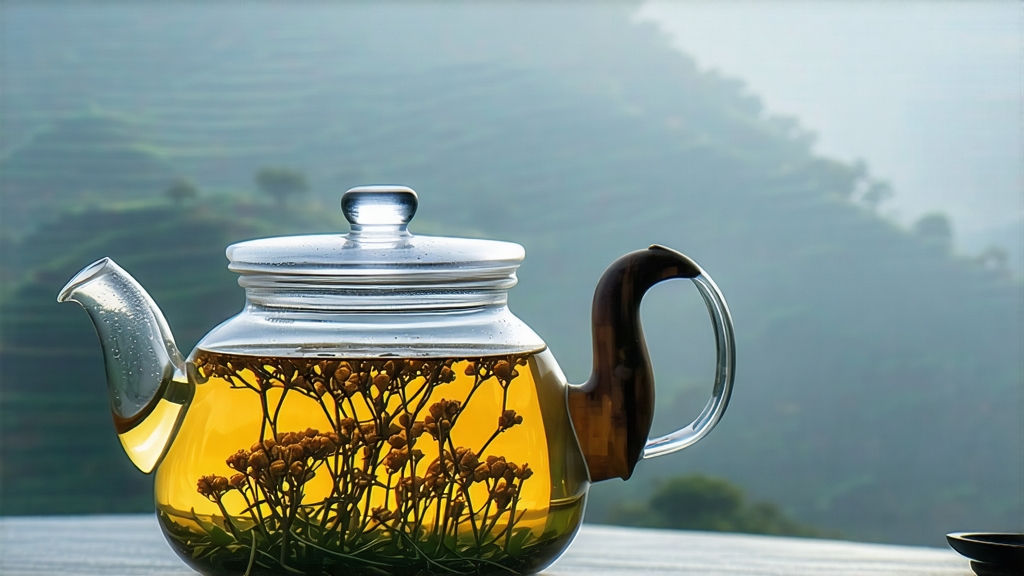
Tucked high on the mist-laden shoulders of Mt. Meng in Sichuan province, Meng Ding Huang Ya has been whispered about in Chinese tea lore for more than twelve centuries. To most Western drinkers “yellow tea” is still a hazy category somewhere between green and oolong, yet this particular yellow bud tea once travelled the entire length of the Jiannan Road to Chang’an, sealed in bamboo tubes and presented to Tang-dynasty emperors who believed its golden liquor carried the breath of immortality. Today only a few hundred kilograms leave the mountain each spring, and almost none of them reach specialty shops outside Asia without the determined help of tea hunters. Understanding Meng Ding Huang Ya is therefore a passport to one of China’s most endangered tea traditions.
History and legend
The first written record appears in the Tang chronicle “Meng Ding Mountain Record” (AD 816), which describes local monks picking “one bud, just opened, at the third watch after dawn” and steaming the leaves in bamboo trays. By Song times the tea had become so coveted that court officials set aside 360 cakes annually for the emperor’s private altar; commoners caught selling counterfeit Huang Ya were reportedly flogged and paraded through the market. When steamed tea gave way to pan-fired tea in Ming China, Meng Ding’s monks adapted, inventing the slow “men huang” (sealed yellowing) process that defines yellow tea today. Republican-era warlord Liu Xiang, himself a native of Ya’an, stationed troops at the mountain gates so that every spring caravan his personal share could start down the Burma Road before the buds lost their fragrance. Such stories explain why older Sichuanese still call it “imperial yellow,” a color once reserved for the dragon robes of the Son of Heaven.
Micro-terroir
Mt. Meng rises 1,450 m above the Chengdu plain, pushing into the cloud belt that rolls in from the Min River. Year-round humidity hovers around 88 %, while diurnal temperature swings of 10–12 °C coax the tea bushes (predominantly a local small-leaf cultivar named “Meng Ding #9”) to store amino acids in their tender buds. The mountain’s Permian sandstone weathers into a loose, slightly acidic loam laced with quartz; rainwater percolates quickly, forcing roots to dive deep for minerals that later translate into a crisp, stone-fruit sweetness in the cup. Because frost can occur even in late March, tea gardens are scattered beneath a canopy of ginkgo, magnolia and bamboo that acts like a natural temperature buffer, adding further complexity to leaf chemistry.
Plucking etiquette
The harvest window opens for barely ten days around the Qingming festival. Only the bud and the first unfolding leaf, no longer than 2.5 cm, are taken. Experienced pickers pinch sideways with the nail of the thumb and middle finger to avoid the heat of skin contact; buds are dropped into shallow bamboo baskets lined with fresh fern fronds that keep them cool and turgid. A full day’s work yields roughly 500 g of fresh leaf, which shrinks to 100 g after processing—one reason authentic Meng Ding Huang Ya costs more than silver by weight.
The men huang craft
Yellow tea’s identity rests on a unique “smother-fermentation” step inserted between initial kill-green and the final drying. At Mt. Meng this is still done exactly as in the 18th century:
- Sha Qing (kill-green): 220 °C on a shallow bronze wok for 3–4 min, enough to destroy leaf enzymes yet preserve a 55 % moisture level.
- Re-wrap Pile: the hot leaves are immediately scooped into linen bags (about 1.5 kg each) and stacked inside a pine-wood chest. The chest is slid onto a heated kang whose surface never exceeds 38 °C. For the next 6–8 h the tea master flips each bag every 30 min, allowing a mild non-enzymatic oxidation that turns chlorophyll into pheophytin and converts catechins into theaflavins—hence the straw-yellow color.
- Zhu Hong (bamboo-roast): leaves are spread on a cylinder of green bamboo screen suspended above a charcoal pit of longan wood. The temperature rises gradually from 60 °C to 85 °C over 90 min, driving off residual moisture while imbuing a whisper